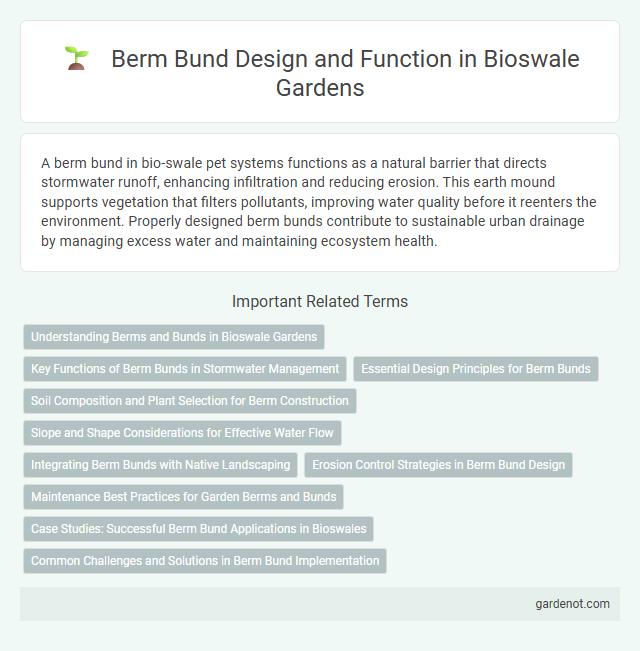A berm bund in bio-swale pet systems functions as a natural barrier that directs stormwater runoff, enhancing infiltration and reducing erosion. This earth mound supports vegetation that filters pollutants, improving water quality before it reenters the environment. Properly designed berm bunds contribute to sustainable urban drainage by managing excess water and maintaining ecosystem health.
Understanding Berms and Bunds in Bioswale Gardens
Berm bunds in bioswale gardens are raised earth structures designed to control water flow and enhance filtration by slowing runoff and encouraging infiltration. These features help trap sediments and pollutants, improving stormwater quality while supporting plant growth within the bioswale system. Proper design and positioning of berms and bunds maximize water retention and prevent erosion, contributing to the overall effectiveness of bioswale gardens in sustainable urban drainage.
Key Functions of Berm Bunds in Stormwater Management
Berm bunds play a crucial role in stormwater management by effectively controlling surface water flow and reducing runoff velocity. These structures facilitate sediment deposition and pollutant filtration, thereby improving water quality before infiltration or discharge. Their strategic placement in bio-swale systems enhances flood mitigation and promotes groundwater recharge.
Essential Design Principles for Berm Bunds
Berm bunds in bio-swale design must prioritize slope stability and appropriate grading to effectively channel stormwater while preventing erosion. Soil compaction levels should be optimized to enhance infiltration without compromising plant root growth or water flow. Vegetative cover selection is critical, favoring native, deep-rooting species that reinforce the bund structure and promote sediment capture.
Soil Composition and Plant Selection for Berm Construction
Berm bund construction in bio-swale systems requires soil with high permeability and organic content to support water infiltration and root growth. Selecting native, deep-rooted plants like sedges, rushes, and grasses enhances soil stability and nutrient uptake, reducing erosion. Proper soil composition combined with strategic plant selection optimizes the berm's effectiveness in managing stormwater runoff and improving water quality.
Slope and Shape Considerations for Effective Water Flow
A berm bund in a bio-swale must have a precise slope, typically between 2% and 5%, to ensure effective water flow without causing erosion or stagnation. The shape should be concave or trapezoidal to facilitate water retention and infiltration while guiding runoff efficiently. Proper contouring of the berm bund supports sediment capture and enhances the bio-swale's overall stormwater management performance.
Integrating Berm Bunds with Native Landscaping
Berm bunds serve as natural barriers that enhance water runoff management while promoting soil retention in bio-swale systems. Integrating berm bunds with native landscaping supports local biodiversity, reduces maintenance needs, and improves stormwater filtration by using adapted plant species that thrive in native soils and climates. This approach not only maximizes ecological benefits but also strengthens the resilience and effectiveness of bio-swales in urban and suburban environments.
Erosion Control Strategies in Berm Bund Design
Berm bund design incorporates erosion control strategies such as vegetation planting, terracing, and the use of geotextiles to stabilize soil and reduce runoff velocity. Strategic placement of berms slows water flow, promoting sediment deposition and minimizing soil loss during heavy rainfall. Integrating native plants with deep root systems further reinforces soil structure, enhancing the longevity and effectiveness of bio-swale systems.
Maintenance Best Practices for Garden Berms and Bunds
Regular inspection and prompt removal of sediment buildup are essential maintenance best practices for garden berms and bunds to ensure effective water flow and prevent clogging. Vegetation management, including selective trimming and planting deep-rooted native species, stabilizes soil and reduces erosion on berm surfaces. Periodic assessment of structural integrity, combined with erosion control measures like mulching and regrading, sustains long-term functionality and aesthetic appeal of bio-swale berms.
Case Studies: Successful Berm Bund Applications in Bioswales
Berm bunds have proven highly effective in bioswales by enhancing stormwater capture and filtration, as demonstrated in the New York City Green Infrastructure Program where berms directed runoff into vegetated swales, reducing combined sewer overflows by 20%. In Portland, Oregon, strategic berm bund installations in bioswales increased pollutant removal efficiency by creating micro-topographic variations that encourage sediment deposition and infiltration. Similarly, the University of California, Davis campus employed berm bunds within bioswales, achieving significant improvements in nutrient retention and urban runoff mitigation, highlighting the role of berm bunds in maximizing bioswale performance.
Common Challenges and Solutions in Berm Bund Implementation
Berm bund implementation often faces challenges such as soil erosion, inadequate water retention, and structural instability due to improper compaction or material selection. Solutions include using geotextiles for reinforcement, optimizing soil composition with clay or organic matter to enhance water retention, and designing appropriate slope gradients to minimize erosion. Regular maintenance and monitoring also help in early detection of seepage issues or vegetation failure, ensuring long-term effectiveness of the bio-swale system.
Berm bund Infographic

 gardenot.com
gardenot.com